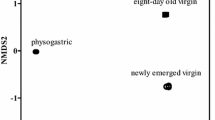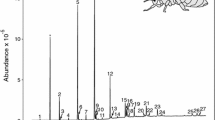Abstract
Males, queens and workers of stingless bees show differences in external morphology, behaviour and roles within a colony. In addition, each individual has a cuticular chemical signature responsible for mutual communication that is essential for maintaining the integrity of the colony. In this paper we characterize the cuticular hydrocarbon composition of newly emerged diploid and haploid males, workers and virgin queens of Melipona quadrifasciata by gas chromatography-mass spectrometry (GC/MS) analysis. This is the first time that the cuticular profile of diploid males in a species of stingless bee has been characterized. We found differences in the cuticular hydrocarbon composition among males, workers and virgin queens, recording both qualitative and quantitative differences among individuals of different phenotypes. However, no compound was found exclusively in diploid males. The cuticular chemical profiles of haploid and diploid males were very similar to those of workers. Moreover, the cuticular lipids of males and workers were significantly different from those of queens. Tricosane, pentacosene-2 and 7-methyl-heptacosane were the compounds responsible for this significant separation. This result correlates with the behavioural and morphological differences among these phenotypes.


Similar content being viewed by others
References
Abdalla F.C., Jones G.R., Morgan E.D. and Cruz-Landim C. 2003. Comparative study of the cuticular hydrocarbon composition of Melipona bicolor Lepeletier, 1836 (Hymenoptera, Meliponini) workers and queens. Genet. Mol. Res. 2: 191–199
Almeida M.G. 1985. Sex determination in bees. XXII. Generalized Malahanobis distances between males and females of the stingless bee Melipona scutellaris Latreille 1811. Rev. Bras. Genet. 8: 603–608
Armitage S., Boomsma J. and Baer B. 2010. Diploid male production in a leaf-cutting ant. Ecol. Entomol. 35: 175–182
Blomquist G.J. and Bagnères A.G.B.A. 2010. Insect Hydrocarbons: Biology, Biochemistry, and Chemical Ecology. Cambridge University Press
Bonetti A.M. and Kerr W.E. 1985. Estudo da ação gênica em Melipona marginata e Melipona compressipes a partir de análise morfológica. Rev. Bras. Genet. 8: 629–638
Carlson D.A. 1989. Dimethyl disulfide derivates of long chain alkenes, alkadienes, and alkatrienes for gas chromatography/mass spectrometry. Anal. Chem. 61: 1564–1571
Carlson D.A., Offor I.I., El Messoussi S., Matsuyama K., Mori K. and Jallon J.M. 1998. Sex pheromone of Glossina tachinoides: isolation, identification and synthesis. J. Chem. Ecol. 24: 1563–1574
Carlson D.A., Geden C.J. and Bernier U.R. 1999. Identification of pupal exuviae of Nasonia vitripennis and Muscidifurax raptorellus parasitoids using cuticular hydrocarbons. Biol. Control 15: 97–106
Camargo C.A. 1979. Sex determination in bees. XI. Production of diploid males and sex determination in Melipona quadrifasciata. J. Apic. Res. 18: 77–83
Camargo C.A. 1982. Longevity of diploid males, haploid males, and workers of the social bee Melipona quadrifasciata, Hymenoptera, Apidae. J. Kansas Entomol. Soc. 55: 8–12
Camargo C.A. 1984. Spermatozoa numbers and migration to the 387 seminal vesicles in haploid and diploid males of Melipona quadrifasciata Lep. J. Apic. Res. 23: 15–17
Campos L.A.O. 1978. Sex determination in bees. VI. Effect of a juvenile hormone analogue in males and females of Melipona quadrifasciata (Apidae). J. Kansas Entomol. Soc. 51: 228–234
Cortopassi-Laurino M. 1979. Observações sobre a atividade de machos de Plebeia droryana Friese (Apidae, Meliponinae). Rev. Bras. Entomol. 2: 177–191
Dietz A. and Lovins R.W. 1975. Studies on the ‘cannibalism substance’ of diploid drone honeybee larvae. J. Georgia Entomol. Soc. 10: 314–315
Engels E. and Engels W. 1988. Age-dependent queen attractiveness for drones and mating in the stingless bees, Scaptotrigona postica. J. Apic. Res. 27: 3–8
Ferreira-Caliman M.J., Nascimento F.S., Turatti I.C., Mateus S., Lopes N.P. and Zucchi R. 2010. The cuticular hydrocarbons profiles in the stingless bee Melipona marginata reflect task-related differences. J. Insect Physiol. 56: 800–804
Francisco F.O., Nunes-Silva P., Francoy T.M., Wittmann D., Imperatriz-Fonseca V.L, Arias M.C. and Morgan E.D. 2008. Morphometrical, biochemical and molecular tools for assessing biodiversity. An example in Plebeia remota (Holmberg, 1903) (Apidae, Meliponini). Insect. Soc. 55: 231–237
Gibbs A.G. 2002. Lipid melting and cuticular permeability: new insights into an old problem. J. Insect Physiol. 48: 391–400
Green C.L. and Oldroyd B.P. 2002. Queen mating frequency and maternity of males in the stingless bee Trigona carbonaria Smith. Insect. Soc. 49: 196–202
Hermann M., Trenzcek T., Fahrenhorst H. and Engels W. 2005. Characters that differ between diploid and haploid honey bee (Apis mellifera) drones. Genet. Mol. Res. 4: 624–641
Herzner G., Schmitt T., Heckel F., Schreier P. and Strohm E. 2006. Brothers smell similar: variation in the sex pheromone of male European beewolves Philanthus triangulum F. (Hymenoptera: Cabronidae) and its implications for inbreeding avoidance. Biol. J. Linn. Soc. 89: 433–442
Howard R.W. and Blomquist G.J. 1982. Chemical ecology and biochemistry of insect hydrocarbons. Annu. Rev. Entomol. 27: 149–172
Howard R.W. and Blomquist G.J. 2005. Ecological, behavioral, and biochemical aspects of insect hydrocarbons. Annu. Rev. Entomol. 50: 371–393
Imai H., Taylor R.W., Crosland M.W.J. and Crozier R.H. 1988. Modes of spontaneous evolution in ants with reference to the minimum interaction hypothesis. Jpn. J. Genet. 63: 159–185
Jackson L.L. and Baker G.L. 1970. Cuticular lipids of insects. Lipids 5: 239–246
Jungnickel H., Da Costa A.J.S., Tentschert J., Patricio E.F.L.R.A., Imperatriz-Fonseca V.L., Drijfhout F. and Morgan E.D. 2004. Chemical basis for inter-colonial aggression in the stingless bee Scaptotrigona bipunctata (Hymenoptera: Apidae). J. Insect Physiol. 50: 761–766
Kerr W.E. 1987. Sex determination in bees. XXI. Number of XO-heteroalleles in a natural population of Melipona compressipes fasciculata (Apidae). Insect. Soc. 34: 274–279
Kerr W.E. 1997. Sex determination in bees (Apinae, Meliponinae) and its consequences. Braz. J. Genet. 20: 601–612
Kerr W.E., Jungnickel H. and Morgan E.D. 2004. Workers of the stingless bee Melipona scutellaris are more similar to males than to queens in their cuticular compounds. Apidologie 35: 611–618
Lockey K.H. 1988. Lipids of the insect cuticle: origin, composition and function. Comp. Biochem. Physiol. 89B: 595–645
Michener C.D. 1974. The Social Behavior of the Bees. Harvard University Press, Massachusetts
Nelson D.R., Dillwith J.W. and Blomquist G.J. 1981. Cuticular hydrocarbons of the house fly, Musca domestica. Insect Biochem. 11: 187–197
Nelson D.R. and Blomquist G.J. 1995. Insect waxes. In: Waxes: Chemistry, Molecular Biology and Functions (Hamilton R.J., Ed), Dundee, Oily Press. pp 1–90
Nogueira-Neto P. 1997. Vida e Criação de Abelhas Indígenas sem Ferrão. Editora Nogueirapis. São Paulo
Nunes T.M., Turatti I.C., Mateus S., Nascimento F.S., Lopes N.P. and Zucchi R. 2009. Cuticular hydrocarbons in the stingless bee Schwarziana quadripunctata (Hymenoptera, Apidae, Meliponini): differences between colonies, castes and age. Genet. Mol. Res. 8: 589–595
Paxton R.J., Bego L.R., Shah M.M. and Mateus S. 2003. Low mating frequency of queens in the stingless bee Scaptotrigona postica and worker maternity of males. Behav. Ecol. Sociobiol. 53: 174–181
Pianaro A., Flach A., Patricio E.F.L.R.A., Nogueira-Neto P. and Marsaioli A.J. 2007. Chemical changes associated with the invasion of a Melipona scutellaris colony by Melipona rufiventris workers. J. Chem. Ecol. 33: 971–984
Provost E., Blight O., Tirard A. and Renucci M. 2008. Hydrocarbons and insects’ social physiology. In: Insect Physiology: New Research (Maes R.P., Ed), Nova Science Publishers, New York. pp 19–72
Ratnieks F.L.W. 1990. The evolution of polyandry by queens in social Hymenoptera: the significance of the timing of removal of diploid males. Behav. Ecol. Sociobiol. 26: 343–348
Reyment R. 1989. Compositional data analysis. Terra Review 1: 29–34
Roubik D.W., Weight L.A. and Bonilla M.A. 1996. Population genetics, diploid males, and limits to social evolution of Euglossine bees. Evolution 50: 931–935
Sakagami S.F. and Zucchi R. 1974. Oviposition behavior of two dwarf stingless bees, Hypotrigona (Leurotrigona) muelleri and H. (Trigonisca) duckei, with notes on the temporal articulation of oviposition process in stingless bees. J. Fac. Sci. 19: 361–421
Santomauro G., Oldham N.J., Boland W. and Engels W. 2004. Cannibalism of diploid drone larvae in the honey bee (Apis mellifera) is released by odd pattern of cuticular substances. J. Apic. Res. 43: 69–74
Silva D.L.N. 1977. Estudos bionômicos em colônias mistas de Meliponinae (Hymenoptera, Apoidea). Bol. Zool. Univ. São Paulo 2: 7–106
Tarelho Z.F.S. 1973. Contribuição ao estudo citogenético dos Apoidea. University of São Paulo, Brasil
Tavares M.G., Irsigler A.S.T., Campos L.A.O. 2003. Testis length distinguishes haploid from diploid drones in Melipona quadrifasciata (Hymenoptera: Meliponinae). Apidologie 34: 449–455
Tavares M.G., Carvalho C.R., Soares F.A.F. and Fernandes A. 2010. Detection of diploid males in a natural colony of the cleptobiotic bee Lestrimelitta sp. (Hymenoptera, Apidae). Genet. Mol. Biol. 33: 491–493
van Veen J.W., Sommeijer M.J. and Meeuwsen F. 1997. Behaviour of drones in Melipona (Apidae, Meliponinae). Insect. Soc. 44: 435–447
Velthuis H.H.W., Koedam D. and Imperatriz-Fonseca V.L. 2005. The males of Melipona and other stingless bees, and their mothers. Apidologie 36: 169–185
Whiting P.W. 1939. Sex determination and reproductive economy in Habrobracon. Genetics 24: 110–111
Wigglesworth V.B. 1964. The life of insects. In: The World Natural History (Carrington R., Ed), The New American Library, New York. pp 383
Wigglesworth V.B. 1970. Structural lipids in the insect cuticle and the function the oenocytes. Tissue Cell 2: 155–179
Woyke J. 1963. What happens to the diploid drones larvae in a honey bee colony. J. Apic. Res. 2: 73–75
Woyke J. 1967. Diploid drone substance - cannibalism substance. Proc. XXI Int. Beekeeping Congr. Maryland, pp 471–472
Woyke J. 1980. Evidence and action of cannibalism substance in Apis cerana indica. J. Apic. Res. 19: 6–16
Zayed A., Roubik D.W. and Packer L. 2003. Use of diploid male frequency data as an indicator of pollinator decline. Proc. R. Soc. Lond. B Suppl 271: S9–S12
Acknowledgments
We thank Izabel Cristina Casanova Turatti for support with the GC–MS analysis. This research was supported by Fundação de Amparo à Pesquisa do Estado de Minas Gerais (FAPEMIG) and CNPq for scholarship provided to A.A. Borges.
Author information
Authors and Affiliations
Corresponding author
Rights and permissions
About this article
Cite this article
Borges, A.A., Ferreira-Caliman, M.J., Nascimento, F.S. et al. Characterization of cuticular hydrocarbons of diploid and haploid males, workers and queens of the stingless bee Melipona quadrifasciata . Insect. Soc. 59, 479–486 (2012). https://doi.org/10.1007/s00040-012-0242-x
Received:
Revised:
Accepted:
Published:
Issue Date:
DOI: https://doi.org/10.1007/s00040-012-0242-x




